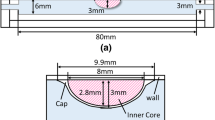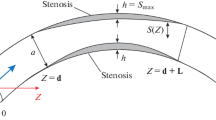Abstract
In the study the influence of the geometry of stenoses on poststenotic flow characteristics such as faminar flow, separation, flow instabilities and local turbulences were assessed. Stenoses were represented by 12 rigid-walled models. The different geometric characteristics were length, percentage lumen area reduction, exit angle and eccentric location of the residual lumen. The flow characteristics were investigated by visualising the flow pattern with a birefringent solution and by measuring the flow and the pressure drop along the stenoses. All data were obtained under steady flow conditions for Reynolds numbers varying from approximately 1 to 500. In stenoses with short and concentric shapes local turbulence develops at Reynolds numbers well below the corresponding Reynolds numbers obtained in stenoses with the same percent lumen area reduction but with a long and eccentric shape. The results indicate that the photoelastic technique is a suitable method of obtaining a picture of the overall flow field downstream of a constriction.
Similar content being viewed by others
Abbreviations
- A, A′ :
-
amplitude of the ordinary and extraordinary beam at the photoelastic apparatus
- d :
-
diameter of stenosis
- D :
-
diameter of unobstructed tube=21 mm
- l :
-
distance between pressure taps
- L :
-
length of stenosis
- ΔP :
-
pressure drop
- Re :
-
Reynolds number=2DU ρ/μ
- Re * :
-
critical Reynolds number
- s :
-
difference between the ordinary and extraordinary beam leaving the test section at the photoelastic apparatus
- U :
-
mean velocity in unobstructed tube
- Z :
-
axial position from the exit of the stenosis
- α:
-
alpha parameter = (D/2)·√2πvρ/μ
- β:
-
exit angle of stenosis
- γ, γ′:
-
orientation of the principal crystal axes
- μ:
-
absolute viscosity of fluid
- ν:
-
pulsation frequency
- ρ:
-
density of fluid
References
Ahmed, S. A. (1981) An experimental investigation of steady and pulsative flow through a constricted tube. Ph.D. Thesis, Georgia Institute of Technology.
Ahmed, S. A. andGiddens, D. P. (1983a) Velocity measurements in steady flow through axisymmetric stenoses at moderate Reynolds numbers.J. Biomech.,16, 505–516.
Ahmed, S. A. andGiddens, D. P. (1983b) Flow disturbance measurements through a constricted tube at moderate Reynolds numbers. ——Ibid.,16, 955–963.
Ahmed, S. A. andGiddens, D. P. (1984) Pulsative poststenotic flow studies with laser Doppler anemometry. ——Ibid.,17, 695–705.
Azuma, T., andFukushima, T. (1976) Flow patterns in stenotic blood vessel models.Biorheology,13, 337–355.
Back, L. H. andRoschke, E. J. (1972) Shear-layer flow regimes and wave instabilities and reattachment lengths downstream of an abrupt circular channel expansion.Trans. ASME, J. Appl. Mech.,39, 677–681.
Caro, C. G., Fitz-Gerald, J. M. andSchroter, R. C. (1971) Atheroma and arterial wall shear observation, correlation and proposal of a shear dependent mass transfer mechanism for atherogenesis.Proc. R. Soc. Lond. B,177, 109–159.
Caro, C. G. (1973) Transport of material between blood and wall in arteries. InAtherogenesis—initiating factors. Ciba Foundation Symposium,12, Academic Scientific Publishers, Amsterdam, 127–164.
Cassanova, R. A. andGiddens, D. P. (1978) Disorder distal to modeled stenoses in steady and pulsatileflow.J. Biomech.,11, 441–453.
Deshpande, M. D., Giddens, D. P., andMabon, R. F. (1976) Steady laminar flow through modelled vascular stenoses. ——Ibid.,9, 165–174.
Fry, D. L. (1968) Acute vascular endothelial changes associated with increased blood velocity gradients.Circ. Res.,22, 165–197.
Fry, D. L. (1969) Certain histological and chemical responses of the vascular interface to acutely induced mechanical stress in the aorta of the dog. ——Ibid.,26, 93–108.
Fry, D. L. (1973) Response of the arterial wall to certain physical factors. InAtherogenesis—Initiating factors. Ciba Foundation Symposium,12, Academic Scientific Publishers, Amsterdam, 93–125.
Fukushima, T., andAzuma, T. (1982) The horseshoe vortex: a secondary flow generated in arteries with stenosis, bifurcation, and branchings.Biorheology,19, 143–154.
Giddens, D. P., Mabon, R. F. andCassanova, R. A. (1976) Measurements of disordered flows distal to subtotal vascular stenoses in the thoracic aortas of dogs.Circ. Res.,39, 112–119.
Kim, B. M., andCorcoran, W. H. (1974) Experimental measurements of turbulence spectra distal to stenoses.J. Biomech.,7, 335–342.
Kirkeeide, R. L. andYoung, D. F. (1977) Wall vibrations induced by flow through simulated stenoses in models and arteries. ——Ibid.,10, 431–441.
Liepsch, D. (1974) Untersuchungen der Strömungsverhältnisse in Verzweigungen von Rohren kleiner Durchmesser (Koronarien) bei Stromtrennung. Dissertation, Technische Universitats München.
Liepsch, D., andMoravec, S. (1984) Pulsatile flow of non-newtonian fluid in distensible models of human arteries.Biorheology,21, 571–586.
Mates, R. E., Gupta, R. L., Bell, A. C., andKlocke, F. J. (1978) Fluid dynamics of coronary artery stenosis.Circ. Res.,42, 152–162.
Moravec, S., andLiepsch, D. (1983) Flow investigations in a model of three-dimensional human artery with newtonian and non-newtonian fluids—I.Biorheology,20, 745–759.
Roach, M. R. (1972) Poststenotic dilatation in arteries. InCardiovascular fluid dynamics, vol. 2.Bergel, D. H. (Ed.), Academic Press, New York, 111–139.
Robbins, S. L., andBentov, I. (1967) The kinetics of viscous flow in a model vessel.Lab. Invest.,16, 864–874.
Rodkiewicz, C. M. (1983) Fluid dynamics. InArteries and arterial blood flow.Rodkiewicz, C. M. (Ed.), Springer Verlag, Vienna, New York, 327–411.
Sacks, A. H., Tickner, E. G. andMacdonald, I. B. (1971) Criteria for the onset of vascular murmurs.Circ. Res.,29, 249–256.
Stein, P. D. andSabbah, H. N. (1980) Hemorheology of turbulence.Biorheology,17, 301–319.
Yongchareon, W., andYoung, D. F. (1979) Initiation of turbulence in models of arterial stenoses.J. Biomech.,12, 185–196.
Young, D. F., andTsai, F. Y. (1973a) Flow characteristics in models of arterial stenoses—I. Steady flow. ——Ibid.,6, 395–410.
Young, D. F. andTsai, F. Y. (1973b) Flow characteristics in models of arterial stenoses—II. Unsteady flow. ——Ibid.,6, 547–559.
Bibliography
Foreman, J. E. K., andHutchinson, K. J. (1970) Arterial wall vibration distal to stenoses in isolated arteries of dog and man.Circ. Res.,26, 583–590.
Forrester, J. H. andYoung, D. F. (1970a) Flow through a converging-diverging tube and its implications in occlusive vascular disease—I.J. Biomech.,3, 297–305.
Forrester, J. H. andYoung, D. F. (1970b) Flow through a converging-diverging tube and its implications in occlusive vascular disease—II. ——Ibid.,3, 307–316.
Kawaguti, M., andHamano, A. (1983) Numerical study on poststenotic dilatation.Biorheology,20, 507–518.
Liepsch, D., Moravec, S. andZimmer, R. (1981) Influence of the hemodynamic effect on vessel alterations.Biomed. Tech.,26, 115–122.
Schlichting, H. (1965)Grenzschicht-Theorie. Verlag G. Braun, Karlsruhe, 5. Auflage, 421–457, 552–587.
Seeley, B. D., andYoung, D. F. (1976) Effect of geometry on pressure losses across models of arterial stenoses.J. Biomech.,9, 439–448.
Young, D. F., Cholvin, N. R., Kirkeeide, R. L., andRoth, A. C. (1977) Hemodynamics of arterial stenoses at elevated flow rates.Circ. Res.,41, 99–107.
Author information
Authors and Affiliations
Rights and permissions
About this article
Cite this article
Solzbach, U., Wollschläger, H., Zeiher, A. et al. Effect of stenotic geometry on flow behaviour across stenotic models. Med. Biol. Eng. Comput. 25, 543–550 (1987). https://doi.org/10.1007/BF02441747
Received:
Accepted:
Issue Date:
DOI: https://doi.org/10.1007/BF02441747




